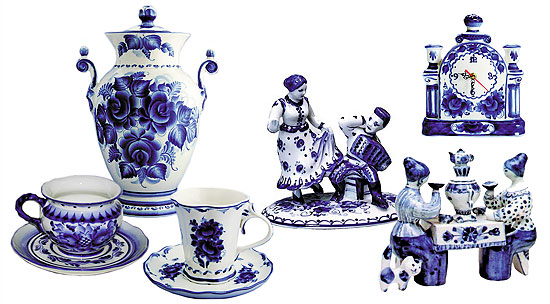GZHEL PORCELAIN
Gzhel porcelain is a traditional Russian folk handicraft which arose and was developed in a place which very early on was famous for its clays. Gzhel is one of the main production centers for these unique ceramic wares, however from a historical and cultural point of view it would be more correct to say the “Gzhel cluster”, since this type of ceramics was made in around 27 villages located roughly 60 kilometers from Moscow on the Moscow-Murom-Kazan railway.
The widespread extraction of different sorts of clay began in the middle of the 17th century, but the first mention of Gzhel is found in the testament of Ivan Kalita back in 1328. This name is later repeated in spiritual writings of other knights and in the testament of Ivan the Terrible in 1572-1578.
Until the middle of the 18th century, Gzhel made pottery typical for the time, making bricks, clay pipes, tiles and also primitive children’s toys, supplying them to Moscow. The number of toys produced at the time is tentatively counted in the hundreds of thousands yearly. The toys were made in the shape of birds and animals, and decorative statuettes on everyday Russian subjects were in demand as well. Shining white horses, horsemen, birds, dolls and miniature dishes were painted with lilac, yellow, dark blue and brown paints in a unique folk style. The paints were applied by a brush. Motifs for this painting included decorative colors, leaves and grass.
After 1802, when light gray clay and the composition of white faience were found, the manufacture of semi-faience was started in Gzhel, as a result of which many kvasniki (for storing the similarly-named beverage), pitchers and jugs were made.
By 1812 Gzhel counted 25 factories producing pottery. Semi-faience was characterized then by its crude structure and weak durability.
The second quarter of the 19th century saw the highest artistic accomplishments of Gzhel ceramics in all regards. Attempting to make thin faience and porcelain, production owners constantly refined the composition of white faience and developed new technologies. At this point they produced semi-faience, faience and porcelain.
Starting with the latter half of the 1820s, many items were painted only in dark blue. It is this unique hand painting with cobalt oxide, which when fired in an oven becomes a rich dark blue, that is the distinguishing trait of wares made from Gzhel porcelain. Some are then decorated with gold as well.
Like watercolors, the paint for this tableware is watered down. The master applies plant (leaves and flowers) or geometric ornaments to the outside of the item with quick, full strokes of the brush. The strokes are even and all of them, it would appear at first, are of the some color. But after firing, the pattern gains a number of shades and tones, making the articles unique. After painting, the items are covered with glaze and fired.
Thanks to the completely by-hand painting, all Gzhel porcelain items are absolutely individual, and the diversity of shapes and drawings on the porcelain will surprise even art mavens. Subjects for Gzhel are taken from real life: at home or impressions from trips around Russia taken to sell pottery. The world of Gzhel ceramics is full of life: girls with buckets, women on horses, family scenes, and wanderers. Also not unnoticed are fairytale characters: a wolf carrying a lamb, or a vulture devouring its kill. Gzhel painting is maximally simple and at times simplistic, but always with sparkling humor and complete recognizability of its characters.
Gzhel today is not only beautiful blue-and-white ceramics, but fireplaces, chandeliers, statuettes, toys, vases and other interior objects – objects which do not only decorate everyday life and make a superb present for foreigners, but are collector’s items as well.

